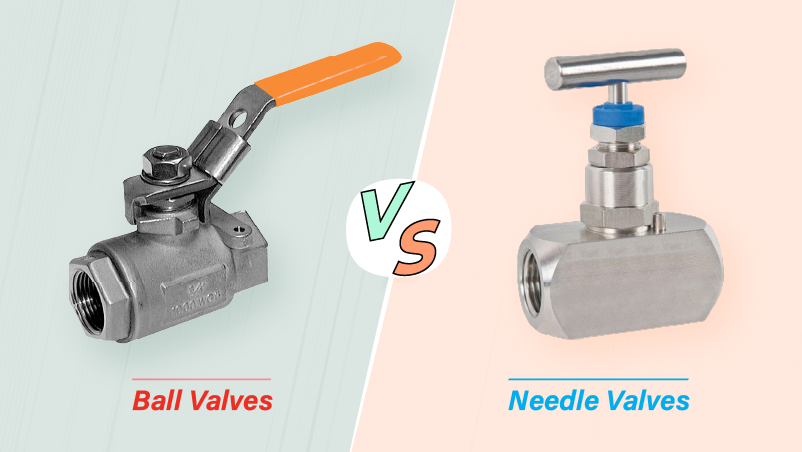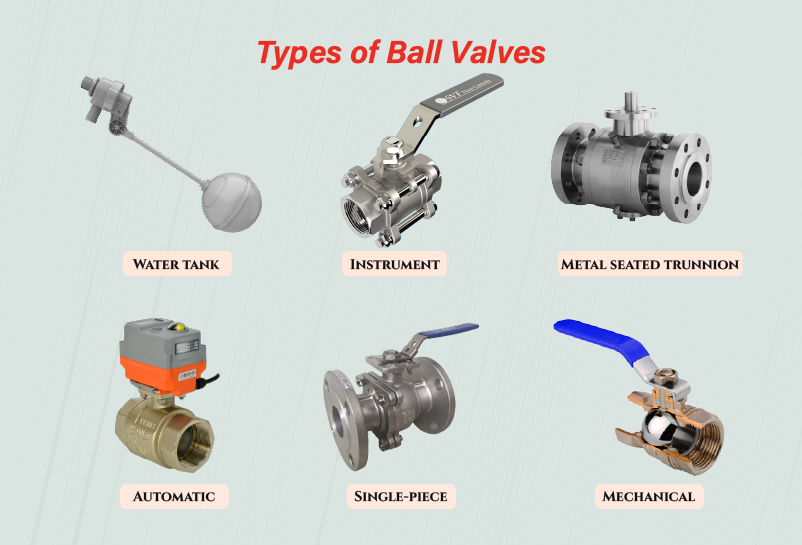Valves are an important part of any plumbing system. Many valves are available, but deciding which goes best with your needs takes time. The common type of valve is a ball valve that has been in the flow system for decades. Besides, a needle valve has features other than the traditional ball valve design. In this article, we have detailed the valves’ flow control and their varied advantages and applications.

Are you searching for valves that have precise flow control? Do you want to know how essential the piping system is for your entire flow control project? A simple piping system assists with transporting material through the entire process of designing an automated multi-step system; flow control is an important part of your project.
Stainless steel valves commonly implement flow control. Moreover, many designs and configurations are required for choosing a proper valve that ensures safety and performance and avoids challenges.
However the two popular valves are ball and needle valves, but what’s the difference? These both are flow control valves that have different ways to control flows. If you are looking for the best fitting that helps manage flow control in industrial control systems, our article can help you. We will mainly discuss the differences between ball and needle valves.
Brief Overview: Flow Control
Flow control is an important part of the piping system. In addition, flow control limits or regulates the flow of liquids, gases or any substance flowing through the piping system. It takes place in the main piping system that helps to control pressure and ensure smooth operations.
If the flow control between valves is balanced, it reduces the risk of damaging sensitive instruments and provides greater control of the monitoring process. Moreover, valves provide flexible means of variables or dynamic flow control that allows to easily increase or decrease flow based on the state of the valve and its desired factors.
Types of Flow Control
Usually, flow control occurs in two ways: on-off control and throttling control.
On-off control
It functions according to the sound of valves. The valves are mostly open or fully closed, which creates an on-off state. Sometimes, the valve works in the middle state between on and off. Hence, there is no accurate way to set the exact flow rate. Moreover, in the intermediate state, it causes damage to the valve or reduces its service life.
Throttling control valves
It allows for variable flow rates with precision adjustment. The overall adjustment and degree of control depend on the valve chosen and the system parameter.
What’s the difference: Ball Valve Vs. Needle Valve?
These two valves have their set of advantages and disadvantages. Ball valves are generally more cost-efficient than needle valves. However, both of these offer strong durability and high reliability and are available in closed positions.
What is a ball Valve?
A ball valve, or an on-off valve, is usually used for flow control in industries. It is a valve that uses a ball-not solid, yet has a hole inside to permit flow when open and stop flow when closed at 90 degrees. It is one of the most used valves in the industry, as it is designed to give exceptional air-tight seals.
Ball Valves are also found as full-bore valves that can be acquired with reduced bore upon request. Moreover, the valve seat is wiped with each actuation, making the cleaning and maintenance requirement minimal.
However, The on-off ball valve is mostly used in residential and commercial settings for HVAC systems and irrigation setups. Besides, they are also used in industries like:
- Oil and gas
- Chemical processing
- Water management
- Fluid flow control and isolation.
What is a Needle Valve?
On the contrary, the Needle valve is as simple as a ball valve, having the on-off valve feature. However, it has many abilities to regulate flow in varied settings. It is due to its needle-shaped plunger, which makes it very durable and withstands high pressure. In addition, the plunger can move up and down, allowing a half-open, barely-open, or fully-opened position.
Due to its small openings, it is an ideal choice to be used for liquid and gases in delicate gauges. The needle valve flow control can stop or slow the flow over time to make gradual adjustments.
However, In instrumentation and gauge isolation application, accurate measurements and control of control variables is important. While, Needle Valves are used in many setups like,
- Laboratories.
- Research facilities.
- Pharmaceuticals.
- Food and beverages.
After justifying the thorough meaning of both the Valves. Lets now move forward to types of Ball Valves and Needle Valves.
Types of Ball Valves and Needle Valves
In this section, we have discussed many popular types of both valves
Ball Valves
Ball valve types are specified as solid, hollow and revolving. We have discussed the best type ball valve below,

Water tank ball valve
A tank ball valve is a spherical ball with a hole. The valve position determines the water passage. However, the handle aligns with the pipe to make a water passage. If the water ball valve is rotated 90 degrees, it halts the water flow. The water tank ball valve is reliable and controllable and is used in various settings.
Automatic ball valve
An automatic ball valve is an advanced plumbing device that regulates the flow without manual operations. It consists of a spherical ball that has a hole at its center and uses an actuator- an electric motor or pneumatic system to control the ball valve position.
However, the automated system enhances precision and reduces labor and time control in a modern process that requires remote or programming fluid adjustments.
Single-piece ball valve
The internal parts consist of a one-piece ball valve, making the liquid overflowing impossible. Single piece ball valves are smaller in diameter; hence, lower in cost.
Moreover, if it’s welded, it’s hard to clean or repair, as it’s damaged. Besides, if the valve is screwed, it can be cleaned, adjusted and repaired, as specific tools can be used.
Instrument ball valve
The instrument ball valve is used in applications where instrument measurement has to be taken. These ball valves are used for isolation, venting, block and bleed, static pressure, absolute pressure, gauge pressure, differential pressure, liquid level and instrument lines.
Mechanical ball valve
The mechanical ball valve is used for pressure control downhole at the packing. It has a seal for pressure above and below the valve that allows the pressure operation to be conducted above a set of packers without annoying formations below. Moreover, it doesn’t require any tubing plugs to be run.
Metal seated trunnion ball valve
A metal seated trunnion ball valve features extra mechanical ball support both at the top and bottom, making it ideal for larger valves and those designed to withstand higher pressure conditions.
Needle Valve
Besides ball valves, needle valves are makes the flow regulated, if open from both the ends.
Screw-in needle valve
Screw-in needle valves consist of a threading system that allows one to screw directly into a system or device, making it easy to install or remove.
Compression needle valve
A compression needle valve uses a compression fitting that helps to connect the valve to a system. It gives a leak-free connection and is easily disassembled.
Bar Stock needle valve
These valves are machined from a solid metal bar to ensure durability and strength. They are mostly used in high-pressure applications.
Straight needle valve
A straight needle valve has an inlet-outlet in a straight line to make a straight flow through the valve. Moreover, its internal design makes the flow through the needle in a zigzag path, also known as a tortuous path.
Angle needle valve
An angle needle valve has an inlet and outlet at 90 degrees from each other. It has less pressure drop than a straight needle valve, making the flow in the right direction.
Multiport needle valve
Multiport- stated as per the name, consists of a single inlet and multiple outlet ports. Majorly, two outlet ports occasionally depend on the application. However, the extra outlet port works to install various instruments, most probably for pressure reading devices.
Besides, all the Valves Ball Valve and Needle Valve are taken into consideration for precise flow control. We shall now discuss the benefits of both the Valves.
Advantages of Ball Valves and Needle Valves
We have listed few benefits of both the valves
Ball Valve
Ball Valve has many benefits, yet the major are discussed below,
Fast Operation and Easy Automation
Ball valve Flow direction becomes swift with just a quarter-turn operation, enabling rapid flow adjustment. It makes them ideal for immediate on-off control.
Minimal Pressure Drop
As it has a full-bore design, the ball valve flow control has less obstruction to flow, which results in no pressure drop around the valve. It gives an efficient system performance.
Suitable for Shutoff Applications
The tight sealing capabilities of the flow control valve make it an effective choice for shutoff application that prevents leakage and backflow.
Durability and Reliability
The stainless steel ball valve is simple in design, having minimal moving parts that enhance strength and reliability even in rough environments.
Needle Valves
Besides on-off ball valve benefits, Needle valves, too, have crucial ones,
Precise Flow Control
Needle valve controls flow is essential for situations where last adjustments are important. Highly resistant to vibration and pressure fluctuations
Needle valves control flow steadily, even in environments surrounded by pressure and vibrations.
Leak-Tight Sealing
These valves have outstanding leak-seal tightening, which is common in low-flow scenes. It reduces the leakage of fluid in such cases.
Temperature resistant
Even with small and delicate openings, needle valves can easily handle any environmental pressure having hot and cold temperatures.
Both of these valves have proven benefits that concludes to its usage. Furthermore, we have discussed the performance of both the valves.
Ball Valve Vs. Needle Valve: Performance Comparison
The main comparison is that ball valves are spherical in shape to open and close and regulate flow, while needle valves regulate the flow if the sides of the pipe are pierced. Moreover, we have listed some performance factors of both valves to help you decide better,
Flow Control Precision
Automatic ball valves are suitable for regular flow control, offering quick on/off capabilities, while precise needle valves can be adjusted for optimal processes.
Pressure Drop
Due to its bore design, the ball valve has a minimal pressure drop, while the needle valve has a high-pressure drop due to its constricted flow path.
Flow Rate
Ball valves go well for higher flow where application movements are efficient. Besides, needle valves are designed for low-flow rates to ensure accurate flow without compromising efficiency.
Leakage
Ball valves consist of shutoff capabilities that minimize the risk of leakage during isolation. On the other hand, the needle valve has tight leakage sealing to handle the flow rate.
Operating Speed
The ball valve has a speedy quarter-turn operation that enables quick flow adjustments. At the same time, needle valves ensure fine-tuning of flow rates.
Which one to choose: Ball Valve or Needle Valve?
You might already know the differences between a ball valve and a needle valve at this phase. You can use that knowledge to select, as requirements are already in your hand.
For instance, if you want to control the fluid from moving through a pipeline at a high flow rate, that ball valve is a got-to-go option. Besides, use a needle valve if you can adjust the flow rate at a minimal valve.
Moreover, it is essential to consider certain aspects regarding your application, such as piping size, pressure capacity, operation temperature and condition, compatibility of material, type of connection and sealing requirements.
Also ball valve price is comparative budget friendly then needle valve.
Conclusion
There are many situations where it is difficult to identify the best. So, if you are in doubt, it is good to contact an expert in the field. However, if you are having trouble finding the best valve for your specific application or would like to know about more kinds of valves, contact a reliable industrial valve manufacturer that offers you the best valve control for your business needs.
Discover the Power of Ball Valves and Needle Valves for your industrial Machinery, Decide Smartly Today.
